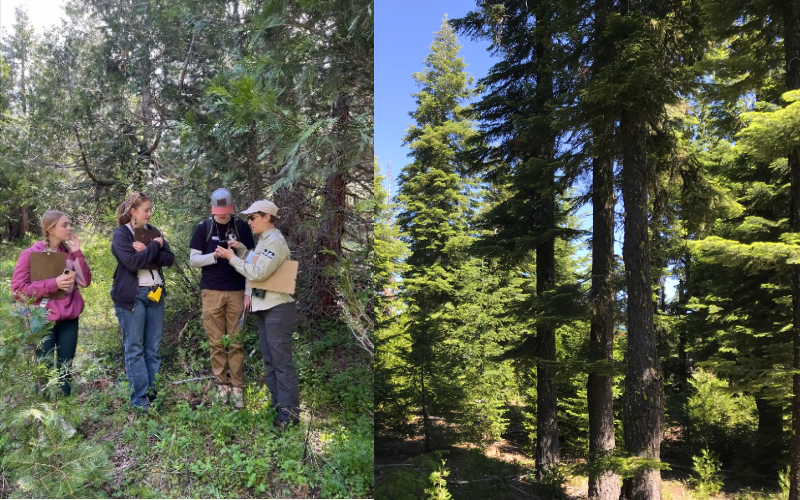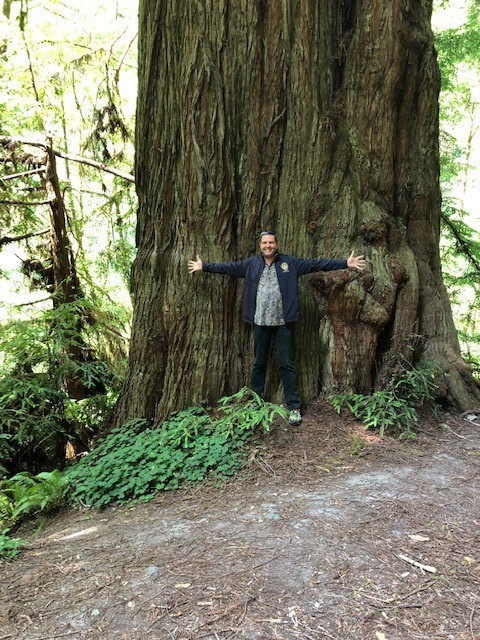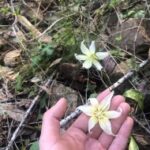FOREST FLASH
JUNE 2024
In Pacific Forest Trust’s e-newsletter, Forest Flash, we send you the most recent PFT news and updates on forests, clean water, climate, and wildlife. Subscribe here.

Late last month, two of our Oregon-based staff took 14 high school students from nearby Phoenix High School out for an inaugural field trip on PFT’s 1,120-acre Mount Ashland Demonstration Forest. The property, with its diverse habitats and high species biodiversity, provided the perfect setting for this introduction to the practice of ecological forest management in the unique Mixed Conifer forests of the Siskiyou Region. All the high schoolers are AP Environmental Science students, and the goal was to learn more about climate-resilient management to restore and maintain healthy forests, especially focusing in on how to manage for and with fire.
First, students were introduced to various forestry techniques, including tree identification, coring to determine age, measurement, and the principles of sustainable forest management as it pertains to ecosystems found in the Klamath Mountains. Then, PFT Stewardship Forester Jack Singer and Lomakatsi Restoration Forester Megan Abeyta led the students on a hike to observe stumps and legacy trees to better understand what the forest was like before initial logging. He led a discussion on the importance of reintroducing low-intensity “good fire” to not only maintain forest health, but also to keep surrounding communities safe from catastrophic wildfire. PFT’s Stewardship and Outreach Associate Emily Bowes and Southern Oregon Land Conservancy’s Land Steward Rebekah Berkgoetter also led the group through the Neil Creek headwaters, located on the property, to talk about the importance of healthy watershed connectivity.
Many of the students who attended the field trip were directly affected by the 2020 Almeda Fire—it devastated their towns and left many families without homes. With that direct lived experience in mind, we felt it especially important to focus on the benefits of restoring safer, more natural fire regimes, and to explain how controlled burns are actually one of the surest ways to keep our beloved communities secure. “This was such a great experience,” shared one pupil, “and I learned that fire can be used as a good thing.”
We are so excited for future educational opportunities on the Mount Ashland Demonstration Forest, and to continue inspiring and empowering the next generation of forest stewards who will offer new ways of combating climate change.

June is legislative high season in California, and PFT has been busy helping state policymakers forge bipartisan consensus and scale up solutions that will help mitigate the increased impacts of climate change and deal with decades of fire suppression as well as forest simplification. Among the bills we are sponsoring is AB2276(Wood). We have worked closely with the California Forestry Association on this bill, which seeks to both consolidate and improve existing exemptions that make it easier and more economical for private landowners to reduce wildfire risk through forest-thinning projects. Authored by Assemblymember Jim Wood, these exemptions moved out of the Senate Natural Resources and Water on June 11th, unanimously.

Assemblymember Jim Wood representing Califronia’s North Coast, author of AB 2776.
This bill renames and expands the Forest Fire Prevention Exemption as the new Forest Resilience Exemption, and increases the maximum project size to 500 acres, thereby allowing landowners to create larger fuel breaks and reduce forest density over wider areas—two practices crucial to reducing the risks of catastrophic blazes. It also revises the maximum allowable diameter of trees that can be removed, allowing field professionals to make more accurate determinations to facilitate thinning of smaller, fire-prone trees. The exemption updates stocking standards to better reflect geographic diversity across California’s forests. To ensure this is not used on high-grade forests, the exemption also requires retention of the six largest trees per acre treated to preserve older, fire-resistant tree structure. These changes aim to provide more cost-effective pathways for landowners to reduce surface fuels and forest density while protecting larger trees and environmentally sensitive areas.
There are additional provisions specifically aimed at conserving oak woodlands from the encroachment of small conifer trees due to the almost 100 years of fire suppression. Both California black oak and Oregon white oak systems have been significantly grown in with fir trees that were formerly contained by the many small fires set by Native Americans to maintain meadows and oaks in the forest mosaic.
Please consider a donation to the Pacific Forest Trust. Your help—in all capacities—makes our work possible. Thanks for supporting us as we support forests!

Spring is always a busy season at PFT, and especially for our stewardship team. Once weather conditions allow, they embark on their annual monitoring trips, where they meet with landowners and take stock of the lands we’ve conserved. Back in April, Stewardship Associate Shay Brown returned to Mendocino County to monitor nine of the 11 conservation easements we have there. These projects span diverse landscapes, from the ancient oak forests of Twining Ranch near Ukiah, to the dense, lush second-growth redwoods and Douglas-firs that line the coastline at both the Oz Farm near Point Arena, as well as the Intertribal Sinkyone Wilderness along the Lost Coast.
These trips often require long days of hiking (bushwhacking, too!) and recording observations in great detail, but they also provide wonderful opportunities for staff like Shay to build relationships with our landowners and witness the lasting impacts of the perpetual protection provided by these easements. At the Green Gorge Forest Property, near Point Arena, Shay was joined on the monitoring walk by owner Hugh Brady along with his daughter, Dae, who is now interested in learning more about how to manage the property. “It is awesome to see that the work that older generations put into keeping the forests in their families has paid off, and younger generations of landowners have the opportunity to engage with the land in different ways and continue their families’ legacies,” said Shay.
- Redwoods at Green Gorge Forest.
- Fawn Lillies at Leonard Lake.
- PFT Stewardship Associate Shay Brown.
ICYMI
In case you missed it (ICYMI), here are some other exciting things PFT has been involved in lately!
- Our pioneering advocacy for wildlife crossings, as well as our commitment to conserving crucial wildlife migration corridors, was highlighted in this great Earth & I article on the topic. “Take our projects, like additions to the Cascade Siskiyou National Monument, Mountcrest Working Forest, and Mount Ashland Demonstration Forest. They’re not just forests, they’re lifelines for wildlife, connecting them to other protected areas and giving them safe pathways to migrate,” PFT President Laurie Wayburn told the publication.
- Laurie also sat down with the Forest History Society for their Forest Optimism webinar series. Watch her talk, “Creating a Viable Future Through Sustainable Resource Economies,” here.
- We’re growing our team of friendly, talented colleagues—and we’d like you to join us and/or spread the word! Click here to learn more about open positions.



